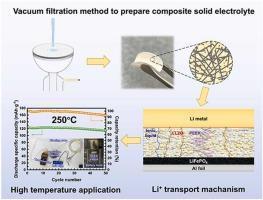当前位置:
X-MOL 学术
›
Nano Energy
›
论文详情
Our official English website, www.x-mol.net, welcomes your
feedback! (Note: you will need to create a separate account there.)
Polymer-based solid electrolyte with ultra thermostability exceeding 300 °C for high-temperature lithium-ion batteries in oil drilling industries
Nano Energy ( IF 16.8 ) Pub Date : 2024-11-13 , DOI: 10.1016/j.nanoen.2024.110475 Xinke Dai, Kaixuan Zhou, Long Zhang, Tianyu Wu, Hai-Mu Ye, Xia Cao, Yu Han, Guoyong Huang, Shengming Xu
Nano Energy ( IF 16.8 ) Pub Date : 2024-11-13 , DOI: 10.1016/j.nanoen.2024.110475 Xinke Dai, Kaixuan Zhou, Long Zhang, Tianyu Wu, Hai-Mu Ye, Xia Cao, Yu Han, Guoyong Huang, Shengming Xu

|
High-temperature lithium-ion batteries (HLBs) are a crucial component in logging while drilling (LWD) equipment, facilitating the date acquisition, analysis, and transmission in myriametric deep formation. Conventional batteries are unable to guarantee a reliable power supply for LWD operations in extreme high-temperature conditions encountered at depths exceeding 10,000 m. Moreover, the development of dedicated batteries for these applications is progressing at a relatively slow pace. In light of these considerations, we put forth a novel proposal: a composite solid-state electrolyte (CSE) for HLB. Poly (ether ether ketone) (PEEK) nanofiber membranes, which are thermally stable at temperatures exceeding 350 °C, were prepared and subsequently composited with Li7 La3 Zr2 O12 (LLZO) by the vacuum filtration method. At room temperature, the PEEK-LLZO composite exhibits ionic conductivity of 1.11 mS·cm ⁻1 and demonstrates stability in lithium-lithium symmetric cells for up to 3500 h. The initial discharge specific capacity was recorded at 132.9 mAh·g ⁻1 at 0.5 C rate, declining to 86.6 % after 500 cycles. Density Functional Theory (DFT) simulations were employed to elucidate the lithium-ion transport mechanisms within the CSE system. It is noteworthy that the CSE displays remarkable thermal stability, with a performance threshold exceeding 300 °C. The ionic conductivity of the CSE system reaches 2.40 mS·cm ⁻1 at 250 °C, representing a twofold increase compared to the LLZO system and an elevenfold increase compared to the LiTFSI molten salt system. Moreover, the initial discharge specific capacity of the CSE was determined to be 123.3 mAh·g ⁻1 at 250 °C and a 1 C rate, retaining 92.8 % of its capacity after 50 cycles. These findings suggest that the CSE exhibits high safety, excellent cycling stability, and considerable potential for application in high-temperature lithium-ion batteries.
中文翻译:

聚合物基固体电解质,具有超过 300 °C 的超热稳定性,适用于石油钻探行业的高温锂离子电池
高温锂离子电池 (HLB) 是随钻测井 (LWD) 设备的关键组成部分,有助于在千米深层中进行测年采集、分析和传输。传统电池无法保证在超过 10,000 米深度的极端高温条件下为 LWD 运行提供可靠的电源。此外,用于这些应用的专用电池的开发进展相对较慢。鉴于这些考虑,我们提出了一个新颖的提议:一种用于 HLB 的复合固态电解质 (CSE)。制备了在超过 350 °C 温度下热稳定的聚醚醚酮 (PEEK) 纳米纤维膜,随后通过真空过滤法与 Li7La3Zr2O12 (LLZO) 复合。在室温下,PEEK-LLZO 复合材料表现出 1.11 mS·cm ⁻1 的离子电导率,并在锂锂对称电池中表现出长达 3500 h 的稳定性。在 0.5 C 倍率下,初始放电比容量为 132.9 mAh·g ⁻1,循环 500 次后下降到 86.6 %。采用密度泛函理论 (DFT) 模拟来阐明 CSE 系统内的锂离子传输机制。值得注意的是,CSE 表现出卓越的热稳定性,性能阈值超过 300 °C。 CSE 系统的离子电导率在 250 °C 时达到 2.40 mS·cm ⁻1,比 LLZO 系统增加了两倍,与 LiTFSI 熔盐系统相比增加了 11 倍。此外,在 250 °C 和 1 C 倍率下,CSE 的初始放电比容量为 123.3 mAh·g ⁻1,循环 50 次后仍保持 92.8% 的容量。 这些发现表明 CSE 表现出高安全性、优异的循环稳定性,并且在高温锂离子电池中具有相当大的应用潜力。
更新日期:2024-11-13
中文翻译:

聚合物基固体电解质,具有超过 300 °C 的超热稳定性,适用于石油钻探行业的高温锂离子电池
高温锂离子电池 (HLB) 是随钻测井 (LWD) 设备的关键组成部分,有助于在千米深层中进行测年采集、分析和传输。传统电池无法保证在超过 10,000 米深度的极端高温条件下为 LWD 运行提供可靠的电源。此外,用于这些应用的专用电池的开发进展相对较慢。鉴于这些考虑,我们提出了一个新颖的提议:一种用于 HLB 的复合固态电解质 (CSE)。制备了在超过 350 °C 温度下热稳定的聚醚醚酮 (PEEK) 纳米纤维膜,随后通过真空过滤法与 Li7La3Zr2O12 (LLZO) 复合。在室温下,PEEK-LLZO 复合材料表现出 1.11 mS·cm ⁻1 的离子电导率,并在锂锂对称电池中表现出长达 3500 h 的稳定性。在 0.5 C 倍率下,初始放电比容量为 132.9 mAh·g ⁻1,循环 500 次后下降到 86.6 %。采用密度泛函理论 (DFT) 模拟来阐明 CSE 系统内的锂离子传输机制。值得注意的是,CSE 表现出卓越的热稳定性,性能阈值超过 300 °C。 CSE 系统的离子电导率在 250 °C 时达到 2.40 mS·cm ⁻1,比 LLZO 系统增加了两倍,与 LiTFSI 熔盐系统相比增加了 11 倍。此外,在 250 °C 和 1 C 倍率下,CSE 的初始放电比容量为 123.3 mAh·g ⁻1,循环 50 次后仍保持 92.8% 的容量。 这些发现表明 CSE 表现出高安全性、优异的循环稳定性,并且在高温锂离子电池中具有相当大的应用潜力。


















































 京公网安备 11010802027423号
京公网安备 11010802027423号